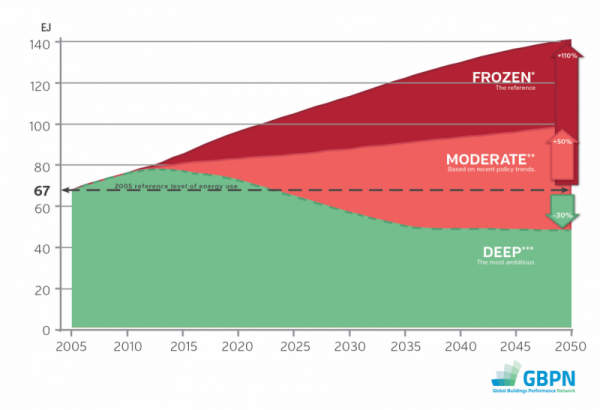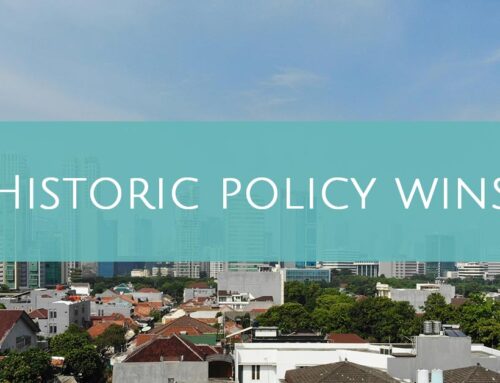Coordinated Global Action is Necessary to Achieve the Buildings Sector’s Mitigation Potential
Over the past two years I have had the pleasure of being involved as a contributing author to the IPCC’s Fifth Assessment Report Working Group III – Chapter 9 on Buildings released today. My involvement has enabled the GBPN to be ‘inside the tent’ along with 235 other scientists and researchers from 58 countries participating in the researching and review of mitigation scenarios and strategies by energy use sectors.
More than 38,000 comments on drafts and redrafts needed to be addressed to finalize this report, which provides evidence that human-caused greenhouse gas emissions have continued to increase and reached an historical high between 2000 and 2010, despite a growing number of policies to reduce climate change.
Chapter 9 highlights again the fundamental scientific consensus that reducing the energy demand of the building sector is key to addressing climate change.
Main findings include (IPCC AR5, 2014, Summary for Policymakers, p. 25):
- In 2010, the building sector accounted for around 32% final energy use and 8.8 Gt CO2 emissions, including direct and indirect emissions, with energy demand projected to approximately double and CO2 emissions to increase by 50–150% by mid‐century in baseline scenarios;
- Recent advances in technologies, know‐how and policies provide opportunities to stabilize or reduce global buildings sector energy use by mid‐century;
- For developed countries, scenarios indicate that lifestyle and behavioural changes could reduce energy demand by up to 20% in the short term and by up to 50% of present levels by mid‐century;
- Most mitigation options for buildings have considerable and diverse co‐benefits in addition to energy cost savings.
The report also states that total carbon emissions from the building sector increased by 19% between 2000 and 2010 (including direct and indirect emissions, i.e, emissions from energy used to provide heat and electricity).

The WG III report supports the GBPN view that advanced polices and technologies are available today to help the buildings sector achieve its mitigation potential.
The report finds that (IPCC AR5, 2014, Summary for Policymakers, p. 26):
- Barriers such as split incentives, fragmented markets and inadequate access to information can be overcome by policy interventions addressing all stages of the building and appliance lifecycles.
- Building codes and appliance standards, if well designed and implemented, have been among the most environmentally and cost‐effective instruments for emission reductions. In some developed countries they have contributed to a stabilization of, or reduction in, total energy demand for buildings.
However, despite some progress made by policy makers to improve the energy performance of buildings, transformational policies for both new and existing buildings need to be implemented at an unprecedented scale (GBPN, 2013). The WG III report acknowledges that: “Substantially strengthening these codes, adopting them in further jurisdictions, and extending them to more building and appliance types, will be a key factor in reaching ambitious climate goals.” (IPCC AR5, 2014, Summary for Policymakers, p. 26).
To achieve this, the GBPN has been investigating state of the art policies that can enable jurisdictions to put their building sectors on a “deep path” for closing the energy and emissions gap in the building sector. Policy priorities include setting long-term performance targets for new buildings that lead to mainstream construction of net zero and positive energy new buildings by 2030 and renovation of existing buildings to reduce energy consumption by between 50%-90%. Significant co-benefits exist. These include creation of local jobs, improving indoor and outdoor air-quality, alleviating risks of energy poverty, and improving energy productivity and climate resilience. (GBPN, 2013).
“Climate change is a global commons problem,” said Ottmar Edenhofer, WG III Co-Chair, and “International cooperation is key for achieving mitigation goals”. The GBPN supports a coordinated global approach to overcome barriers and achieve the mitigation potential of the building sector. Our priorities focus on facilitating capacity building through exchange of independently verified best-practices, data and MRV methodologies for enabling access to carbon financing, and the development of local markets in energy efficiency technologies.
The next report – the IPCC Synthesis Report – is now expected by the end of October. Let’s not wait for this last piece of work before taking action, join the GBPN’s effort, contact us and support our activities!
WG III’s Accomplishments:
Video interview with O. Edenhofer, IPCC WG III Co-Chair: “We are handing over the map to the Navigators”.
Ottmar Edenhofer, IPCC WGIII Co-Chair from IPCC WGIII on Vimeo.
Related Report Bundles
Share This Story, Choose Your Platform!
Stay in touch with how we’re transforming the buildings sector
GBPN runs innovative building policy reform programs in key regions around the world that aim to tackle the climate emergency by decarbonising the buildings sector. Stay up to date with our newsletter.
Stay in touch with how we’re transforming the buildings sector
GBPN runs innovative building policy reform programs in key regions around the world that aim to tackle the climate emergency by decarbonising the buildings sector. Stay up to date with our newsletter.






